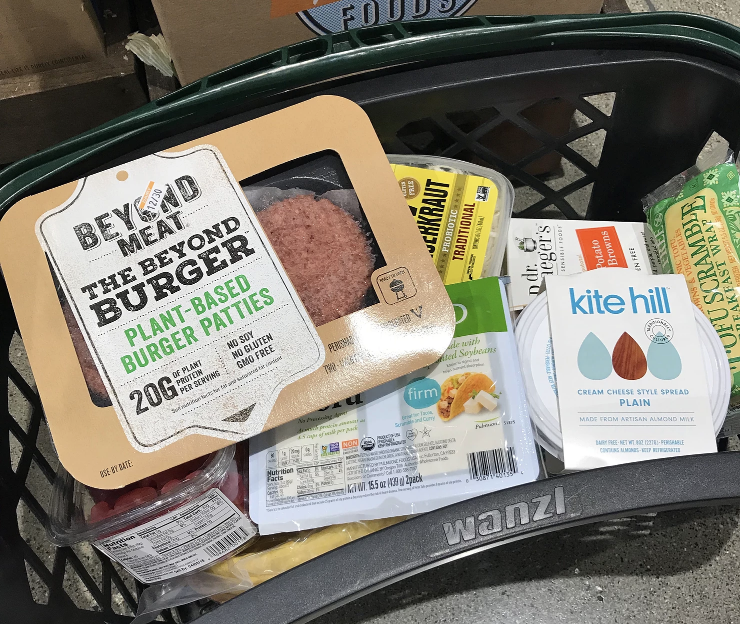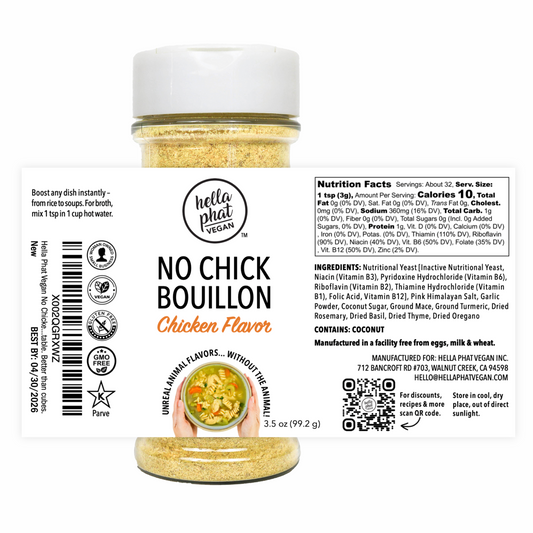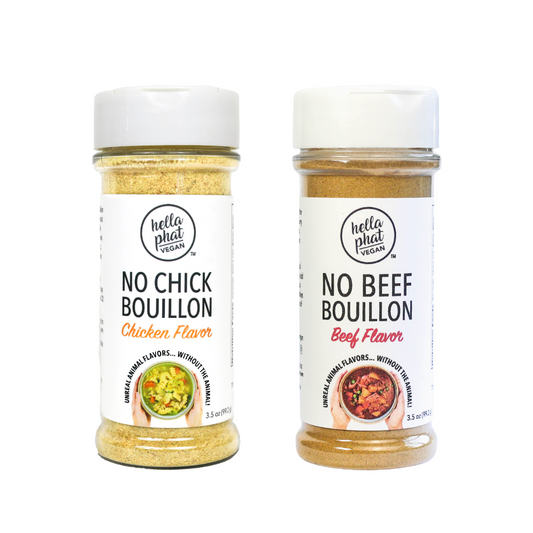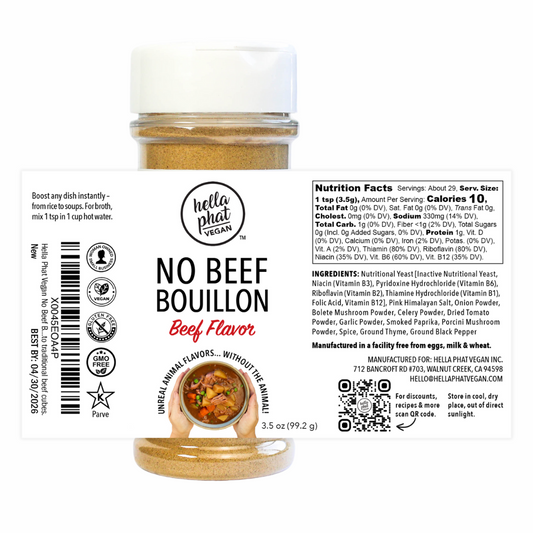Don't be fooled by the fancy wording used by corporations on their food packaging. There's a lot of additives, fillers and chemical processes that they don't want you to know about.
Vegan processed foods are still processed foods...
In the beginning I found myself buying A LOT of prepackaged vegan foods, in particular plant based meats. They taste just like real meat and it really helped me transition to a vegan lifestyle.
I must admit I went a little overboard.
I was eating vegan sandwiches, burgers, corn dogs, sausages, TVP, seitan, faux seafood, ground meats, the list goes on. I had also increased my intake of wheat during this time because well let's be honest it goes great with everything (vegan butter included!) Not only that but most of the faux meats are made of wheat gluten.
I started gaining weight and wasn't feeling my best.
This was the reverse effect of what I was expecting. I started feeling pain and swollen joints which was something I used to experience before I started eating a low carb diet (in my pescetarian days). I started to really question if these symptoms had anything to do with the increase of wheat and vegan meats I was consuming.
Wheat Gluten
I never really knew much about wheat and just thought it was a delicious piece of bread that is only bad because it's a carbohydrate. The new wave of paleo diets came out claiming "carbs are the enemy" (fat bastard voice from Austin Powers) and I mainly connected wheat with carbs and gaining weight. I didn't realize what was going on in the background with the food industry. I could probably go on all day about gluten so I recommend watching "What's With Wheat?" this is how I learned how gluten affects the gut. I wrote a blog article about 6 must watch documentaries and this documentary is on that list.
How do you know?
Everyone has a different reaction to gluten but too much isn't good for you either. Some people can have an allergy or sensitivity and react to it in different ways including irritable bowel syndrome, stomach upset, skin reactions, brain fog and more. The only way to really know if you have a sensitivity or allergy is to cut out gluten completely. It could take a few weeks for the gluten to get out of your system and to see results.
For me I received immediate relief from the headaches, bloating, pain and swelling of the joints that I was experiencing. I even started to think clearer and the eczema that I had started to go away. I noticed if I ate gluten by accident I would immediately start to get symptoms so it became clear to me that I have a sensitivity to gluten. After cutting it out for so long I'm able to eat gluten once in a while as long as I don't go too crazy with it.
If you have a gluten sensitivity
Be aware that gluten is in EVERYTHING. I found it in my body moisturizer, vitamins, chapstick, hot sauce, BBQ sauce, chips and in almost all the delicious fake meats I was buying. Luckily there are some vegan food companies that make all their products gluten free. Be sure to check the packaging for the ingredients sometimes you can't trust that it's completely gluten free if it says so on the front of the packaging.
I recommend checking the allergen information to make sure it wasn't made in the same facility as wheat. It will usually read "may contain wheat". Some people can have a reaction to gluten even from cross contamination.
Ascorbic acid
Ascorbic acid is a common preservative used in a lot of processed foods. I was surprised to learn that ascorbic acid is derived from either wheat or corn. To be on the safe side I typically just stay away from it altogether or you can research the company and the product to see where they get their ascorbic acid from.
I tend to Google everything to see if it's gluten free. There's a celiac forum where a lot of people post questions of what is gluten free so there's a lot of resources out there to check if something is gluten free or not.
Seitan AKA Wheat Gluten
Seitan is very interesting. The first time I tried seitan I bought it from the store and it didn't taste that great. When I moved to Toronto I started to see seitan being used a lot at the vegan restaurants I was going to. I even saw it being sold fresh in bulk at a health food store. It tastes way better fresh and I discovered how easy it is to make from scratch. I personally prefer TVP over seitan when it comes to texture and taste. BUT if you are allergic or have a sensitivity to gluten, seitan is out of the question. It's literally straight gluten.
TVP (Textured Vegetable Protein)
I first heard about TVP when I bought my first vegan cookbook. One of the recipes was a TVP chick'n salad. I found a bag of Bob's Red Mill TVP at the grocery store and made the recipe. It turned out pretty good but that was the extent of my TVP cooking.
When I moved to Toronto I found TVP chunks, slices and grounds all in the bulk section of the health food store. It was so cheap and after learning about my gluten sensitivity I was happy I still had TVP as a meat alternative. I started experimenting with it more and discovered the perfect chicken flavored TVP recipe (I now turned it into a business and sell it. Learn more by clicking here).
What is TVP anyways?
I went to my trusted friend Google and typed in "Is TVP good for you?" and pulled up the first article. I wasn't expecting to find what I did. I thought I would find only positive things about it but was shocked to find out how TVP is actually made.
Let's take a deeper look into TVP
TVP is made of "defatted" soy protein soy flour. The soybean is soaked in a hexane bath to extract all the oils from the bean. This technique is the most effective way to extract all the oils from the bean opposed to the traditional way of soaking the bean in water.
Please note this is the same process used to extract oils for cooking. I now will only buy organic cold-pressed oils if available or expeller pressed (uses high heat which can denature the oil), both are chemical-free ways of extracting the oil from the nut, seed or fruit.
Also, keep a look out for soy protein isolate manufacturers use the same hexane bath to extract the oil from the protein. This is a common ingredient in protein powders, protein bars and unfortunately baby formula.
What is hexane?
Hexane is a byproduct of gasoline and is a toxic chemical if inhaled. Some factory workers have experienced hexane poisoning from being exposed to this chemical. It's a neurotoxin and if exposed to it if for long periods of time can cause vertigo, drowsiness, fatigue, loss of appetite, paresthesia in the distal extremities, muscle weakness, cold pulsation in the extremities, blurred vision, headache and anorexia.
Hexane has been named a health hazard by the US Environmental Protection Agency as well as The National Institute for Occupational Safety and Health. So why are we eating it in our foods and oils?
Food companies state that there's very little trace of hexane left in the foods after this type of processing. Studies have been done on rodents (sad face) with foods that have been processed with hexane containing trace amounts. They didn't find anything during these studies but I really wonder if they did their due diligence and who conducted and funded these studies? Also, how can you be sure it doesn't cause any long term adverse effects?
I personally decided to discontinue my intake of TVP and was determined to find a chemical free alternative.
The good news!
Yes, there's good news. I know I've been going on and on about all the negative aspect of vegan foods but there's always a light at the end of the tunnel.
We didn't always use chemicals to process our foods and more companies are being made aware of this issue. The Cornucopia Institute has some great resources to identify what companies use hexane free ways of processing their soy and what companies are on the good or naughty list.
How can you be sure the foods are hexane free?
Hexane has been banned in the use of organic foods. So a general rule of thumb always choose certified organic so you know without a doubt they're hexane free.
There's always an alternative
It's my goal to start making my own foods instead of buying them as processed foods. There's too much to think about when purchasing processed foods from the grocery store. Most processed foods have so many ingredients listed on the packaging, some, I can't even pronounce. Unless you make it yourself or you find a really conscious food company it's hard to know what is being put into your food.
If you have a gluten allergy or sensitivity but don't want to miss out on the delicious breads, crackers and baked goods there's so many alternative flours to replace all purpose flour. I always keep multiple kinds of flours in stock because they all have their unique uses. You can read more about which kinds of flour and starches I always have on stock in my pantry blog post here.
I did a lot of research to find a non-chemical TVP replacement. I stumbled upon organic TSP (Textured Soy Protein). Bob's Red Mill also sells this so if you want to stay away from hexane you can buy his organic TSP. I've tried some organic TSP from NOW Foods and it's great just like the TVP I used to eat. TSP unlike TVP extracts the oil from the soybean the traditional way with good old water!
Key takeaway
If something says "natural" it doesn't mean it's free of any chemicals. Always buy certified organic to be sure there's no hexane or any other added chemicals.
If you have a gluten sensitivity remember gluten is in everything so don't always assume it's gluten free. Check your personal healthcare products, vitamins and food packaging ingredients to ensure the product is truly gluten free and wasn't processed in the same facility as wheat if you're very sensitive.





